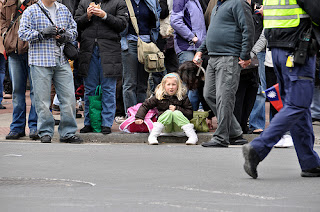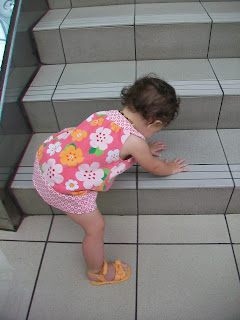This week’s guest post is from Melissa of The New Mommy Files! Don’t forget to check out her site after you fall in love with her post :0)
 |
| Photo Used by Creative Commons License
Credit: Kevin Harber (Kevin H.) on Flickr. |
It’s hard to imagine what the world looks and feels like for a very small child. Every piece of furniture in a standard house is too large to climb on to unassisted. People may be all around you, but it’s all but impossible to tell what they’re doing, since you have to crane your neck to see above their waist. You can only go as far as the room you’re in, unless someone has been kind enough to leave a door open for you. Even if they have, it may have been by mistake and no sooner will you make it into the next room than someone will swoop in unannounced to scoop you up and take you back to the place they think you ought to be.
Leaving the house requires that you be strapped tightly into a seat, where your movement is restricted and you can see very little. If you’re lucky, you may be taken to a park or some other open space where you can be free to move about and explore at will. There’s a good chance that you may be going along on errands, however, where you are just as ill-fitted to the space around you. Again you may find large furniture, items too high for you to reach, people who either ignore you altogether, or reach in to touch you without your permission and perhaps make silly, unintelligible noises to coerce you into performing for them with a smile or a giggle. For lack of something better to do, you oblige.
The vast majority of spaces we find ourselves in on a regular basis are designed specifically to be comfortable for adults. The law dictates that they be made accessible to differently-abled adults, so most make at least the bare minimum of effort required to be within the law, but there are no laws requiring that establishments consider the children who may visit them. The children do not have a vote, so they are expected to make do with what they are given.
This is a very sad state of affairs. There is no more important time than childhood for an individual’s development, but children cannot develop freely without space to move about. Without environments suited to their needs, numerous obstacles are placed in the path of the child’s development. As adults, we often fail to see the problem, because everything works just fine for us.
The Montessori “Children’s Houses” were created as an answer to this problem by providing a space where children can move about freely. Every piece of furniture in a Children’s House is scaled to the child’s size so that it can be used by them, and even moved about and rearranged at will. All of the items in the Children’s Houses, including the art, are placed at the child’s level so that they can be easily enjoyed. Everything in the environment is safe for the child and is placed there for his or her use. For those children who attend a Montessori school, this is wonderful, but what about the rest?
We can prepare our homes to welcome our children, providing furniture that is suited to them and items for them to use and explore placed at their level. We can design safe spaces for our children so that they can be permitted to explore without danger or interference from adults. There is much that we can do in our own homes, but what about when we leave the home?
The older my daughter Annabelle gets, the more she wants to explore, and the more challenges I am faced with when we’re out and about. She needs opportunities to explore, and opportunities to move about unhindered, but this can be a real challenge in places like the grocery store, where people are moving about without looking down at her level, and could easily collide with and harm her, and where there are many enticing items that are not safe for her to touch. I have implemented a few strategies that allow me both to respect Annabelle, and respect the space that we’re in, but I still find myself feeling as though I’m forcing her to conform to expectations that are not reasonable or realistic for her, because the space we’re in affords me no other choice. I would love to hear your thoughts, and what works for you.
 |
| Taking some time to climb the stairs at the mall
before picking up groceries |
- Leave plenty of extra time to get things done, so that it’s easy to move at Annabelle’s pace without becoming stressed or frustrated.
- Allow time before and after going into a place where Annabelle cannot safely walk about (such as a crowded grocery store), to allow her to walk and explore. I let her wander around on the lawn outside the grocery store for awhile before going inside, for example.
- Have more than one plan. When we go out shopping, I bring a sling and our shopping cart cover with a favorite object and a snack tucked inside the pocket. When Annabelle tires of riding in the cart, I place her in the sling instead. This respects her need for a change of scenery, and also gives her two separate places from which she can have a bird’s eye view. We don’t use a stroller, as it keeps her from being able to interact with me and others around us. When we’re in a place where she can safely walk, I allow her to do so.
- Empathize and speak respectfully. Occasionally Annabelle becomes frustrated at points when it’s hard for me to step away and tend to her immediately, such as when my groceries are already half checked and I need to pay for them. When this happens, I simply do my best to acknowledge her needs and let her know that I will meet them just as soon as I can. Her feelings of frustration are valid and she needs to know that she is heard.
I do believe that there is value in taking our children out into the community where they can see new people and places and experience our culture and the world firsthand. It’s also not realistic for many parents, myself included, to avoid taking our children on errands, even if we’d like to. They deserve our consideration, however, both for their emotional needs and for their physical development – no matter where we are. We owe it to them to make space for them wherever and whenever possible.
How do you make space for your children at home? What about outside the home? Do you take your children on errands, or leave them behind?
 Melissa started blogging at The New Mommy Files when her firstborn was just three months old, but has found that no matter how familiar the mommy label becomes there is always something new to discover. She shares stories, thoughts, ideas, and inspiration from her journey on facebook and twitter as well as on her blog. In addition to mothering, topics that come up often include Montessori philosophy, elimination communication and cloth diapering, veganism, and finding a rhythm and balance in everyday life.
Melissa started blogging at The New Mommy Files when her firstborn was just three months old, but has found that no matter how familiar the mommy label becomes there is always something new to discover. She shares stories, thoughts, ideas, and inspiration from her journey on facebook and twitter as well as on her blog. In addition to mothering, topics that come up often include Montessori philosophy, elimination communication and cloth diapering, veganism, and finding a rhythm and balance in everyday life.
 Award-winnning author, L.R.Knost, is the founder and director of the children's rights advocacy and family consulting group, Little Hearts/Gentle Parenting Resources, and Editor-in-Chief of Holistic Parenting Magazine. Books by L.R.Knost include Whispers Through Time: Communication Through the Ages and Stages of Childhood ; Two Thousand Kisses a Day: Gentle Parenting Through the Ages and Stages ; The Gentle Parent: Positive, Practical, Effective Discipline ; and Jesus, the Gentle Parent: Gentle Christian Parenting the first four books in the Little Hearts Handbook gentle parenting series, and children’s picture books Petey’s Listening Ears and the soon-to-be-released Grumpykins series.
Award-winnning author, L.R.Knost, is the founder and director of the children's rights advocacy and family consulting group, Little Hearts/Gentle Parenting Resources, and Editor-in-Chief of Holistic Parenting Magazine. Books by L.R.Knost include Whispers Through Time: Communication Through the Ages and Stages of Childhood ; Two Thousand Kisses a Day: Gentle Parenting Through the Ages and Stages ; The Gentle Parent: Positive, Practical, Effective Discipline ; and Jesus, the Gentle Parent: Gentle Christian Parenting the first four books in the Little Hearts Handbook gentle parenting series, and children’s picture books Petey’s Listening Ears and the soon-to-be-released Grumpykins series.
September 16, 2011 | Categories: attachment parenting, babywearing, breastfeeding, children's books, cosleeping, gentle parenting, life | Tags: attachment parenting, babywearing, breastfeeding, childhood, children, cosleeping, gentle discipline, sacrificial parenting | 4 Comments »

 Melissa started blogging at The New Mommy Files when her firstborn was just three months old, but has found that no matter how familiar the mommy label becomes there is always something new to discover. She shares stories, thoughts, ideas, and inspiration from her journey on facebook and twitter as well as on her blog. In addition to mothering, topics that come up often include Montessori philosophy, elimination communication and cloth diapering, veganism, and finding a rhythm and balance in everyday life.
Melissa started blogging at The New Mommy Files when her firstborn was just three months old, but has found that no matter how familiar the mommy label becomes there is always something new to discover. She shares stories, thoughts, ideas, and inspiration from her journey on facebook and twitter as well as on her blog. In addition to mothering, topics that come up often include Montessori philosophy, elimination communication and cloth diapering, veganism, and finding a rhythm and balance in everyday life. Award-winnning author, L.R.Knost, is the founder and director of the children's rights advocacy and family consulting group, Little Hearts/Gentle Parenting Resources, and Editor-in-Chief of Holistic Parenting Magazine. Books by L.R.Knost include Whispers Through Time: Communication Through the Ages and Stages of Childhood ; Two Thousand Kisses a Day: Gentle Parenting Through the Ages and Stages ; The Gentle Parent: Positive, Practical, Effective Discipline ; and Jesus, the Gentle Parent: Gentle Christian Parenting the first four books in the Little Hearts Handbook gentle parenting series, and children’s picture books Petey’s Listening Ears and the soon-to-be-released Grumpykins series.
Award-winnning author, L.R.Knost, is the founder and director of the children's rights advocacy and family consulting group, Little Hearts/Gentle Parenting Resources, and Editor-in-Chief of Holistic Parenting Magazine. Books by L.R.Knost include Whispers Through Time: Communication Through the Ages and Stages of Childhood ; Two Thousand Kisses a Day: Gentle Parenting Through the Ages and Stages ; The Gentle Parent: Positive, Practical, Effective Discipline ; and Jesus, the Gentle Parent: Gentle Christian Parenting the first four books in the Little Hearts Handbook gentle parenting series, and children’s picture books Petey’s Listening Ears and the soon-to-be-released Grumpykins series.







